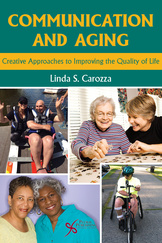Publication
Communication and Aging
Creative Approaches to Improving the Quality of Life
- Details:
- 319 pages, Illustrated (B/W), Softcover, 6 x 9"
- ISBN13:
- 978-1-59756-612-4
- Release Date:
- 08/17/2015
Overview
Communication and Aging: Creative Approaches to Improving the Quality of Life provides an overview of alternative approaches used to improve the quality of life of individuals with long-term chronic communication diseases associated with aging and neurogenic diseases. This text examines how professionals can inspire and develop programs that allow patients to live successfully with their disorders.
Key features include:
- Detailed descriptions of successful therapeutic modalities (such as art, music and drama) and the ability of patients and families to participate and benefit
- Real-life examples of programs that combine nondirective strategies with outcome measure assessment
- Discussion of social models and contrast theories of medical models of patient rehabilitation
- Examination of the effect of social integration on patient quality of life and wellness
Communication and Aging is a source for innovative therapeutic planning and is ideal for professionals seeking to stretch the boundaries of support to patients who may have maximized private pay and directive therapy options.
Review
Susan J. Behrens, Ph.D., Professor of Communication Sciences and Disorders (October 2015):
"...This contributed volume offers the reader the expertise from a range of professionals in the communication field. It is timely: Our population is aging, and so is the rise in cases of dementia, Alzheimers, and other age-related disorders. The book presents the treatment of communicative conditions associated with aging not only in an inter-professional way, emphasizing teamwork, but in a holistic way. That is, we do not see isolated impairments but quality of life concerns for the individual and his/her loved ones. As we are rightly told, the aim is adding life to the years, not just years to life. The book also offers information to a range of readers: those in the aging population, their family, friends and caregivers, as well as the students in communication sciences and disorders and the active practitioner. We all need to better understand the process of aging, what is normal and what are the signs of disease, what treatments are available, and how the field can continue to improve by focusing on the quality of life for all involved..."
Part I.
Chapter 1. Introduction
- Tanya Budilovskaya
Chapter 2. Perspectives on Communication and Aging
- Noel Shafi and Linda S. Carozza
Chapter 3. Cognitive Changes in Aging: Implications for Discourse Processing
- Tricia Olea Santos
Chapter 4. The Effect of Aging and Neurogenic Conditions on Speech Production: Recent Advances
- Linda S. Carozza
Chapter 5. Language Comprehension and Production in Dementia and Aphasia
- Linda S. Carozza
Chapter 6. Hearing and Aging
- Abbey L. Berg and Yula C. Serpanos
Chapter 7. Swallowing Functions Across the Lifespan
- Matina Balou
Chapter 8. Social Language Enhancement in Dementia and Aphasia
- Linda S. Carozza with contribution by Noel Shafi
Part II.
Chapter 9. Psychosocial and Creative Approaches to Dementia Care
- Lauren Volkmer
Chapter 10. Creating the Climate for Contact and Positive Change in the Social Adult Day Program Setting: An Interview with Elizabeth Hartowicz, Director of CARE Program at Lenox Hill Neighborhood House
- Elizabeth Hartowicz
Chapter 11. Color My Words: How Art Therapy Creates New Pathways of Communication
- Raquel Chapin Stephenson
Chapter 12. Music Therapy in Neurologic Dysfunction to Address Self-Expression, Language, and Communication: The Impact of Group Singing on Stroke Survivors and Caregivers
- Joanne V. Loewy, Jamee Ard, and Naoko Mizutani
About The Author
Linda Carozza, PhD, CCC-SLP, is the Founding Director of the MS program in Communication Sciences and Disorders at Pace University in New York City, as well as a Clinical Assistant Professor in the Department of Rehabilitation Medicine at New York University Langone Medical Center. She has authored several books, numerous articles and is a frequent invited speaker. Her research and practice is in adult neurogenic communication disorders.
Related Titles
Neurogenic Communication Disorders
Barbara B. Shadden, Fran Hagstrom, Patricia R. Koski
257 pages, Illustrated (B/W), Softcover, 7 x 10"
Aphasia Rehabilitation: The Impairment and Its Consequences
Nadine Martin, Ph.D., Cynthia K. Thompson, Ph.D., Linda Worrall, Ph.D.
277 pages, Illustrated (B/W), Softcover, 6 x 9"
Brain-Based Communication Disorders
Leonard L. LaPointe, Bruce E. Murdoch, Julie A. G. Stierwalt
265 pages, Color Illustrations (4 Color), Hardcover, 7 x 10"
Science of Successful Supervision and Mentorship
331 pages, Illustrated (B/W), Softcover, 6 x 9"
Communication and Swallowing in Parkinson Disease
Edited by: Deborah Theodoros, Lorraine Ramig
256 pages, Illustrated (B/W), Softcover, 7 x 10"
Hearing and Aging
192 pages, Illustrated (B/W), Softcover, 6 x 9"
Here's How to Treat Dementia
Jennifer L. Loehr, Megan L. Malone
200 pages, Illustrated (B/W), Softcover, 8.5 x 11"
Adult Neurogenic Language Disorders
392 pages, Illustrated (B/W), Softcover, 7 x 10"
MCI and Alzheimer's Dementia
Kathryn Bayles, Cheryl K. Tomoeda
232 pages, Color Illustrations (2 Color), Softcover, 6 x 9"
Augmentative and Alternative Communication in Acute and Critical Care Settings
Richard R. Hurtig, Ph.D., Debora Downey, CCC-SLP
224 pages, Illustrated (B/W), Softcover, 7 x 10"



















